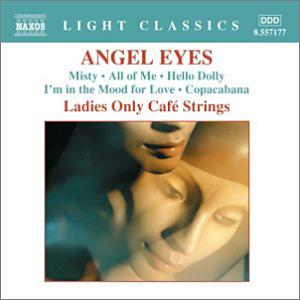Angel Eyes: Ladies Only Café Strings
Various
Erik FRANCK arr KALLIN Noveltyflicken, (The novelty girl)
Errol GARNER/KALLIN Misty
Olrog arr. OHLSON Filosofisk Dixieland (Philosophic Dixieland)
Seymour SIMONS arr. MARKS All of me
Hogey CARMICHAEL arr.KALLIN Stardust,
Neal HEFTI arr. KALLIN Splanky,
Jimmy MCHUGH I'm in the mood for love
Ulf OLROG arr. OHLSON Rattjakt fur tva (Rat chase for two)
Matt DENNIS arr. KALLIN Angel Eyes
Lasse SAHLQUIST arr. KALLIN Geaspeagen (Goose-boy)
Jerry HERMAN arr. KALLIN Hello Dolly
Jules CATY Con Amore
Erik FRANK arr.KALLIN Novelty Accordion
Bert CARSTEN Zigenarens serenade (Gypsy Serenade)
Morgan LEWIS trans KALLIN How high the moon
Jerry HERMAN Revydags ( Cabaret time)
Alvar KRAFT trans. by KALLIN Botvid/Lite grand fran ovan Botvid (A little bit from above),
Barry MANILOW arr. KALLIN Copacabana
Ladies Only Café Strings
Recorded at Orebro Konserthus in June 2001. DDD
Available on Naxos 8.557177
Running time: 63.14
Crotchet Amazon UK Amazon US

This CD, which comes in Naxos's Light Classics series, takes its title from one of the tracks which have been arranged, like ten others by Lars Kallin. The other arrangers, all new names to me, are Kalle Ohlson and Gerald Marks. Both are equally skilled and classy.
The performers are a group of ladies, classically trained, who play in the Swedish Chamber Orchestra, an ensemble which also records regularly for Naxos. They consist of Katarina Andersson, Charlotte Wargert and Christrina Olofsdotter Hallberg (violins), Linn Lowengren Elkulland Kate Pelly (violas), Kersti Manell (cello) and Helena Nordquist, (double bass). They regularly play together on Swedish television's lunch-time 'café programmes' (which sounds most civilized). This CD gives an excellent cross-section of the various styles of music in which they indulge.
The booklet notes, which are very nicely written by Peter Dempsey, explain it all well: "In a variety of contrasting styles the pieces selected are over-tinged with an 'olde-worlde' or even 'pseudo-baroque' flavour, which adds charm, for example, to Jules Caty's pseudo-Edwardian 'Con Amore'". This is probably the only salon piece reminiscent of the Edwardian drawing room on the CD, although I must say that Hogey Carmichael's 'Stardust' of 1929 comes a close second. Then there's 'Hello Dolly', cheekily arranged by Lars Kallin, with its pizzicato double bass and syncopated inner parts.
'Novelty Accordion' is at first a sleazy number before turning up-beat in a 1920s style, the tune even disappears for a time into the double-bass. 'Zigenarens serenad' gives us a dark tremolando opening and the wistful song of the gypsies to a passionate tango melody, Piazzolla style. 'How High the Moon' offers us a boogey-woogey bass under the melody with a violin counter-melody sounding almost improvised. Every number is individual and juicy.
It's good also to hear the viola on its own in various places particularly in such uncharacteristic music. Peter Dempsey explains how salon music came about in the very early 20th century. He comments that 'Salon Music' was the Edwardian equivalent of 'Palm Court' and he adds that it provided "regular work in recording studios where output was as prolific as it was diversified".
The recording is warm and beautifully balanced but it is a curious oversight that the track titles have not been translated from the Swedish for the international market. I have added the translations in the above titles, (in brackets) but probably it makes very little difference, because if you respond to this music then that is all that matters.
Gary Higginson
4
Return to Index